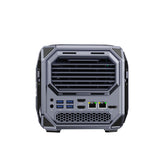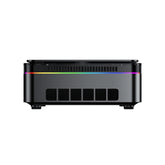HDMI vs. Micro HDMI vs. Mini HDMI: The Ultimate Comparison Guide

In today's digital age, HDMI (High-Definition Multimedia Interface) has become the essential connector for linking modern devices such as televisions, computer monitors, mini PCs, smartphones, and tablets. As technology advances, HDMI has evolved to include Mini HDMI and Micro HDMI variants to accommodate portable devices like digital cameras and ultrabook laptops. This variety in HDMI types offers greater flexibility in device design but can also make choosing the right HDMI connector confusing for users.
This article will compare HDMI, Mini HDMI, and Micro HDMI, outlining their key differences, pros and cons, and suitable use cases. By understanding these distinctions, you can make informed decisions to ensure seamless device connections and enjoy the best audio-visual experience.
What is HDMI?
HDMI (High-Definition Multimedia Interface) is a standard interface used for transmitting digital audio and video signals. Since its introduction in 2003, HDMI has quickly become the mainstream choice for connecting various electronic devices, widely used in home entertainment systems, computers, and mobile devices.
The core function of HDMI is to enable high-quality digital audio and video transmission. Unlike traditional analog interfaces, HDMI can simultaneously transmit uncompressed high-definition video and multichannel audio through a single cable, ensuring synchronization and clarity of both image and sound. Additionally, HDMI supports Digital Rights Management (DRM) technologies, such as HDCP (High-bandwidth Digital Content Protection), to prevent unauthorized copying and distribution of content.
Detailed Overview of Different HDMI Types
What is Standard HDMI?
Standard HDMI (Type-A HDMI) features a connector size of 13.9mm × 4.45mm. This larger rectangular connector includes 19 pins, ensuring a stable connection. The standard HDMI connector can only be inserted in one way, preventing incorrect connections.

Advantages
- Supports a variety of devices, as almost all HDMI-enabled devices use the standard HDMI connector.
- Supports the latest HDMI standards, such as HDMI 2.1, with bandwidth up to 48Gbps, enabling 4K, 8K, and high refresh rates.
- The larger connector size ensures a secure connection, reducing the likelihood of poor contact.
Disadvantages
- The standard HDMI connector is too bulky for portable devices, making it unsuitable for compact designs.
- Using standard HDMI ports in mobile devices takes up more space, affecting the slim design of the device.
Mini HDMI, What Should You Know?
Mini HDMI (Type-C HDMI) has a connector size of 10.42mm × 2.42mm, slightly smaller than the standard HDMI but still maintains a rectangular shape with 19 pins. Despite its reduced size, Mini HDMI offers the same functionality and performance as the standard HDMI.

Advantages
- Compact Size: Mini HDMI takes up less space compared to standard HDMI, making it ideal for portable device designs.
- Same Performance: Supports the same high resolutions and bandwidth transmission as standard HDMI.
- Versatility: Many Mini HDMI cables come with dual connectors (Type-A and Type-C), enhancing compatibility and convenience.
Disadvantages
- Limited Applications: Compared to standard HDMI, Mini HDMI has a narrower application range, mainly concentrated in specific portable devices.
- Susceptible to Wear: The smaller connector may wear out or get damaged more easily with frequent plugging and unplugging.
What is Micro HDMI?
Micro HDMI (Type-D HDMI) is the smallest HDMI connector, measuring 5.83mm × 2.20mm. It resembles a micro-USB connector and also has 19 pins, although the pin layout differs from standard and Mini HDMI.

Advantages
- Ultra-Compact Size: Micro HDMI is the smallest HDMI connector, suitable for ultra-thin and compact device designs.
- High-Performance Transmission: Supports the same high resolutions and bandwidth as standard HDMI, ensuring quality audio and video experiences.
- Lightweight and Portable: Ideal for devices that require a lightweight design, such as smartphones and compact camcorders.
Disadvantages
- Limited Applications: Due to its extremely small size, Micro HDMI is primarily used in specific mobile devices and has lower prevalence.
- High Susceptibility to Damage: The smaller connector is more prone to damage with frequent use, affecting its lifespan.
- Rise of Alternative Technologies: With the growing popularity of versatile interfaces like USB-C, the use of Micro HDMI is gradually declining, with some devices shifting to USB-C to HDMI adapters.
Comparison of HDMI, Mini HDMI, and Micro HDMI

| Comparison Criteria | Standard HDMI (Type-A) | Mini HDMI (Type-C) | Micro HDMI (Type-D) |
| Connector Size & Shape | 13.9 mm × 4.45mm, rectangular shape, 19 pins | 10.42mm × 2.42mm, smaller rectangular shape, 19 pins | 5.83mm × 2.20mm, micro-USB-like shape, 19 pins |
| Common Device Applications | Televisions, computer monitors, gaming consoles, home theater systems | Tablets, digital cameras, ultrathin laptops | Smartphones, portable camcorders, ultrathin laptops |
| Supported Resolution & Bandwidth | Up to 48Gbps (HDMI 2.1), supports 4K/8K@120Hz | Same as Standard HDMI, supports high resolutions and bandwidth | Same as Standard HDMI, supports high resolutions and bandwidth |
| Compatibility | Broad compatibility, supported by almost all HDMI devices | Requires adapter to connect to Standard HDMI devices, suitable for portable devices | Primarily used in specific mobile devices, gradually being replaced by USB-C |
| Durability & Portability | High stability, but large size is unsuitable for mobile devices | More compact, suitable for portable devices, but may wear out with frequent use | Smallest size, highly portable, but more prone to damage |
| Price & Availability | Generally low-priced, widely available in the market | Slightly more expensive than Standard HDMI, still fairly common | Relatively expensive, fewer options available, supply gradually decreasing |
Different 1: Connector Size and Compatibility
Standard HDMI (Type-A) features the largest connectors, making it ideal for large devices like televisions, computer monitors, and gaming consoles. Its substantial size ensures a stable connection but makes it unsuitable for portable devices. Mini HDMI (Type-C) offers a smaller alternative, tailored for portable electronics such as digital cameras and ultrathin laptops. However, connecting Mini HDMI to Standard HDMI devices typically requires an adapter. Micro HDMI (Type-D) is the smallest HDMI variant, designed for ultra-compact devices like smartphones and portable camcorders. Despite its portability, Micro HDMI has lower compatibility and is gradually being replaced by the more versatile USB-C interface.
Recommended Reading: Difference Between USB A vs USB C & Which One is Better
Different 2: Signal Quality and Transmission Capability
All three HDMI types support high resolutions and high bandwidth transmissions, ensuring excellent audio and video quality. There is no significant difference in signal performance between Standard HDMI, Mini HDMI, and Micro HDMI. The primary distinctions lie in their physical sizes and how well they integrate with various devices.
Different 3: Durability and Portability
Standard HDMI connectors are highly durable due to their larger size and less frequent plugging and unplugging, making them reliable for long-term use in fixed setups. Mini HDMI provides a more compact solution suitable for portable devices but may experience wear and tear with frequent use. Micro HDMI, while offering the highest level of portability, is the least durable and more prone to damage because of its delicate and smaller connector design.
Different 4: Price and Availability
Standard HDMI cables are generally affordable and widely available, making them easy to purchase from most retailers. Mini HDMI cables are slightly more expensive than their Standard counterparts but remain fairly common, especially in accessories for portable devices. In contrast, Micro HDMI cables tend to be pricier and have fewer options available in the market. Additionally, as USB-C becomes increasingly popular, the demand and supply for Micro HDMI cables are steadily declining.
Conclusion
This article has summarized the key features and suitable use cases of Standard HDMI (Type-A) , Mini HDMI (Type-C) , and Micro HDMI (Type-D) connectors. Standard HDMI (Type-A) is ideal for large devices like televisions, computer monitors, and gaming consoles due to its broad compatibility and high transmission performance. Mini HDMI (Type-C) , with its compact design, is perfect for digital cameras, tablets, and ultrathin laptops. Meanwhile, Micro HDMI (Type-D) caters to ultra-compact devices such as smartphones and portable camcorders, meeting the connectivity needs of the smallest gadgets.
Choosing the right HDMI type is crucial based on your specific requirements. For large home electronics, Standard HDMI is recommended to ensure stable audio and video transmission along with extensive device compatibility. For portable devices like digital cameras and tablets, Mini HDMI offers a space-saving and high-performance solution. For the smallest devices, Micro HDMI or USB-C to HDMI adapters are the ideal choices. By considering factors such as device type, portability, compatibility, and future trends, you can select the most suitable HDMI type to ensure efficient and stable audio-visual connections.
Frequently Asked Questions
1. Are HDMI, Mini HDMI, and Micro HDMI interchangeable?
HDMI, Mini HDMI, and Micro HDMI are not directly interchangeable due to their different connector sizes. However, you can use adapters or specialized cables to connect devices with different HDMI types, ensuring compatibility between various devices.
2. Can Micro HDMI do 4K?
Yes, Micro HDMI cables that comply with HDMI 1.4 or newer standards can support 4K/UHD resolutions. Ensure that the cable packaging indicates HDMI 1.4 compatibility or higher to guarantee 4K transmission capabilities.
3. Does Micro HDMI work the same as HDMI?
Micro HDMI functions similarly to standard HDMI by transmitting uncompressed digital audio and video signals. The primary difference lies in the connector size, with Micro HDMI being much smaller, making it suitable for compact devices.
4. What is the main difference between HDMI and Mini HDMI?
The main difference between HDMI and Mini HDMI is the connector size. Mini HDMI (Type-C) is smaller, designed for portable devices like cameras and tablets, whereas standard HDMI (Type-A) is larger and typically used for TVs, monitors, and gaming consoles.
5. Do Micro and Mini HDMI carry audio?
Yes, both Micro HDMI and Mini HDMI cables carry audio along with video signals. They support the same high-quality, uncompressed digital audio formats as standard HDMI, ensuring a complete multimedia experience.
6. Why are Micro and Mini HDMI rare?
Micro and Mini HDMI ports are less common because many modern portable devices are shifting towards USB-C for their versatility and compactness. USB-C can handle video, audio, data, and power through a single connector, reducing the need for multiple specialized ports like Micro and Mini HDMI.
Related articles
Difference Between USB A vs USB C & Which One is Better
HDMI 1.4 vs 2.0: What's the Difference and Which One Should You Choose?







Leave a comment
Please note, comments need to be approved before they are published.